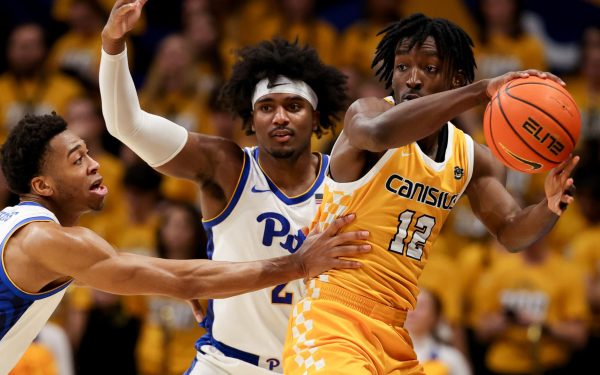Students learn the ins-and-outs of museums from Pitt
Image via University of Pittsburgh
Pitt students discuss art while at the Carnegie Museum of Art.
January 14, 2022
Pittsburgh is home to a large number of museums, which feature exhibits from multimedia art to geology. Luckily, Pitt has a major that prepares students specifically for work in these special places.
The museum studies major and minor programs encourage students to pursue their artistic interests and to explore the work that goes on behind the scenes within the museums that surround Pitt campus.
Museum studies started as a single course offered to students in 2009. The program eventually expanded to offer a minor, and, as interest grew, the department speculated on a major option. Nearly a decade later, in 2018, Pitt’s History of Art and Architecture department began to work on the curriculum for a museum studies major. The department officially offered museum studies as an undergraduate major starting in 2021.
The department now offers both a major and minor option for students to study the history and politics of museology. The program encourages hands-on work through curation within museums and exhibitions and helps students find internships.
Gretchen Bender, the assistant chair director of undergraduate studies for the HAA department, said the museum studies major is for students interested in studying the complexities of history through research, as well as the preservation of art and cultural materials.
“Museum studies is a perfect complement for students who are looking to connect their studies in fields like history and anthropology to public-facing, community-oriented outcomes,” Bender said, “and to develop practical skills that can help connect studies in these fields to diverse public audiences.”
However, the minor and major are open to all students, not just those interested in art and history. Bender said the programs attract students from a variety of interests.
“We’ve also had students from fields like biology and chemistry in the major, some looking towards careers in science museums, others preparing for graduate study in conservation,” Bender said.
Celia Kaine, a junior psychology major and museum studies minor, said she chose to pursue a minor due to her interest in art and art history.
“I’ve always really liked learning about art and art history, but also about the cultural impact of art in today’s society and in the past,” Kaine said.
Kaine’s minor consists of foundational classes discussing interconnection between society and museums, as well as two classes where students study the history of museums and art exhibitions.
“We actually learn about the inner workings of museum work,” Kaine said, “whether that be learning about curatorial work, exhibition practice or actually doing an internship where you learn about these things in museums.”
Kaine said she enjoys the museum studies minor largely because of the discussions in class about creating artistic spaces. She said creating artistic spaces and museum displays requires a lot of behind-the-scenes work.
“What I think is so fascinating is that you get to learn about how curators and artists create unique and eye-opening experiences by grouping different works of arts,” Kaine said. “There’s some really interesting work being done right now where museums are working on making art spaces even more inclusive.”
Museum studies additionally offers connections to internships for students interested in working closely with artistic institutions, according to Kaine.
“I think you’d be surprised how prevalent art’s influence is in modern history and also in Pittsburgh,” Kaine said. “It’s just super interesting to learn about. I plan to do an internship either this upcoming spring semester or next fall.”
Alex Taylor, an assistant professor and academic curator of the HAA department, said the program curriculum prepares students for internships with local organizations.
“We work closely with students to help them identify and prepare to apply for an internship with a local museum, gallery or archive, or some other kind of professional project,” Taylor said. “While students are undertaking their internships, we mentor them to help them make the most of their professional experience.”
Taylor said students have worked with a variety of organizations including The University Art Gallery and the Carnegie Museum of Natural History.
“Almost every cultural institution in the Pittsburgh area has been involved in this program. In the last five years, almost 150 students have gained experience in some 25 local cultural institutions,” Taylor said.
Bender said the program provides students with curation and collection skills built through the UAG.
“The University Art Gallery provides the laboratory for the program’s practical requirements,” Bender said. “Plus, we work closely with local institutions like the Carnegie Museum of Natural History to allow our students to get hands-on experience beyond exhibitions.”
The work that museum studies students pursue varies. Taylor said museum studies interns have contributed to almost every aspect of working in a museum setting.
“Some work directly with visitors, while others focus on the work that goes on behind the scenes,” Taylor said. “All of these experiences help students discover what kind of work they are most interested in for their own careers and provide valuable experience when they apply for jobs in the cultural and nonprofit sectors.”








